If you’re searching for the best subtractive synth plugins to unlock fat analog bass, lush pads, and expressive leads in your productions, this guide covers my top picks with unique features, workflow tips, and real-world advice for both seasoned producers and synth newcomers.
Looking to jazz up your tracks with the fattest basses, lushest pads, or soaring leads? You’re in the right place! I’ve handpicked my favorite subtractive synth plugins from must-have free gems to cutting-edge paid instruments, so you can find the perfect sound no matter your style or budget.
Worried you’ll get lost in a sea of options? Don’t sweat it! I’ve highlighted each plugin’s standout features, shared my own go-to use cases, and even answered some common synth FAQs to make your sound design journey easier.
Whether you’re a seasoned synth nerd or a total beginner, there’s something unique here for everyone, let’s dive in and spark some inspiration!
1. Audible Genius Primer 2
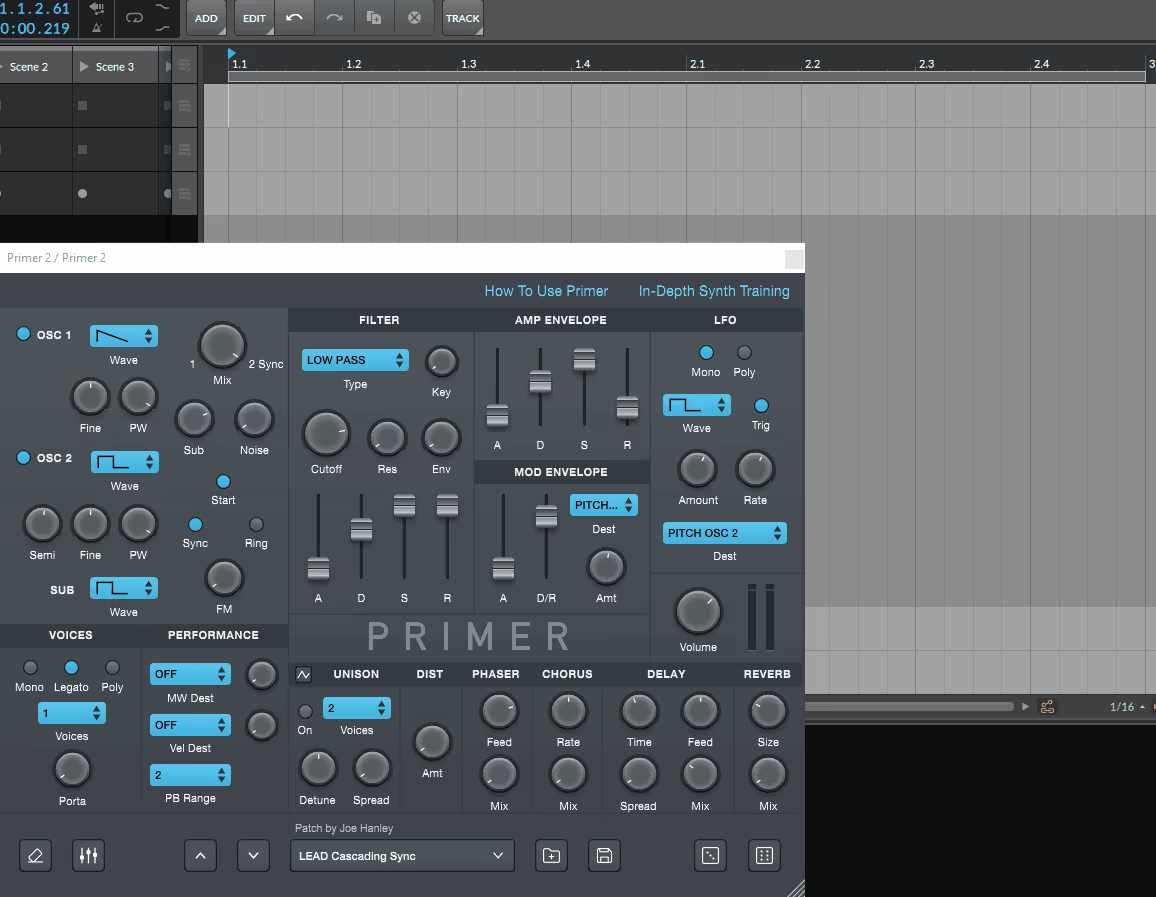
You know those times when you just want to create, not get trapped fiddling with a million tiny synth knobs? That’s where Primer comes in.
I’ve always found it to be one of the most welcoming synths out there, no judgment, no overwhelm…Just crystal-clear sound design that honestly makes learning and experimenting a blast.
The interface is wonderfully inviting, with everything perfectly lined up and ready to go. Whenever I’ve wanted to show a newcomer what subtractive synthesis can do, Primer’s been my go-to because you can immediately see and hear what every tweak is doing (the little visualizer is a lifesaver).
- Classic Oscillators, Zero Fuss
You’re working with 2 main oscillators and a chunky sub-oscillator, which cover all the basics from saw to sine. Every time I want to dial up some extra attitude, having built-in FM and ring modulation makes it effortless to get creative without feeling lost.
- Easy Filters and Fast Envelopes
I find the multimode filter with resonance and key tracking super intuitive, letting me quickly shape my sounds without guesswork.
Between the filter, amp, and modulation envelopes, I can build punchy basses or smooth evolving pads in seconds, and I truly appreciate seeing those curves and changes live on-screen.
- Modulation & Effects
I use the LFO all the time to liven things up; one dial, instant movement, and you can throw it at 7 different parameters.
Plus, the onboard effects (like chorus, phaser, delay, and more) mean I don’t have to stack extra plugins just to finish a patch. Primer always keeps things fun, fast, and inspiring.
With 400 presets and some iconic sounds built in, I never run out of cool places to start, even when I’m in a creative rut.
I keep coming back to Primer whenever I want a distraction-free workflow, whether I’m sketching a new melody, teaching a friend the basics, or just need a synth that feels friendly.
If you want a welcoming doorway into subtractive synthesis with no intimidation, you can’t go wrong with this one.
Primer comes in VST, AU, and VST3 formats for macOS and Windows users.
2. Image Line Harmor
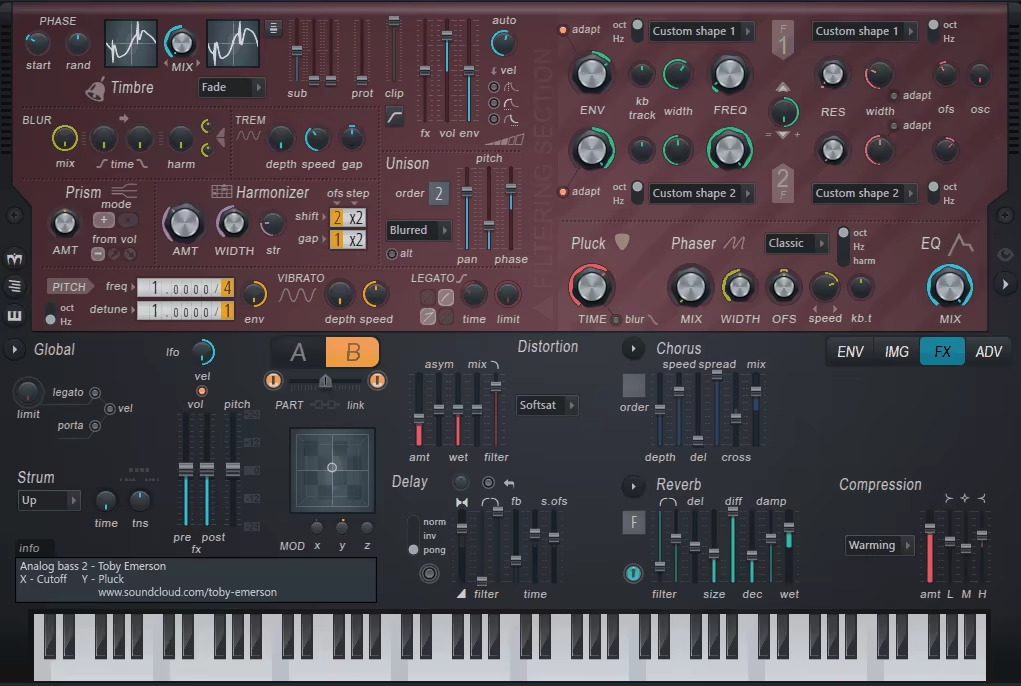
Honestly, Harmor is a total game-changer if you ever felt boxed in by traditional subtractive or FM synths.
The thing that impresses me every time is how you can literally drag an audio file or even a picture, right onto the synth, and suddenly you’re remixing it as a playable instrument. I don’t know about you, but “painting with sound” makes me feel way cooler than I actually am.
The Harmor workflow can feel a bit overwhelming at first (I definitely stared blankly at the screen the first couple times), but once you get your hands dirty, the payoff is huge.
I love that everything’s visual: the spectral display dances in real time as you tweak, and you’ve got full control over every harmonic. I find myself losing track of time just drawing in envelopes or layering weird resynthesized vocals with the image synth options.
- Resynthesis Magic
For me, the biggest thrill is dragging in any sound, like a vocal hook or snare hit and having Harmor rebuild it using hundreds of harmonics.
Suddenly, I’m time-stretching, modulating, or morphing it in ways no sampler or wavetable synth can touch. Oh, and the formant shifting gets wild if you want alien voices or instrumental sounds straight out of left field.
- Image-Based Sound Design
Yeah, you can actually throw a JPEG or PNG into the plugin and “play” the photo, which always impresses friends on producer night.
I use it for unpredictable textures or layering unique noises under more straightforward patches. Want your kick drum turned into a glitchy rhythm based on your cat’s selfie? Believe me, Harmor’s got you.
- Deep Modulation and Multistage Envelopes
I love that almost every single parameter can have a custom multistage envelope or LFO. Sometimes, I’ll take a drum break, drop it onto an envelope, and Harmor will trace out the wobble for me instantly.
And yes, you get all the classic FX, compression, reverb, delay, distortion, chorus without the need to clutter up your mixer with extra plugins.
The only real downside is the learning curve: it’s definitely more intimidating than your average subtractive synth. And, too bad it’s Windows-only, but if you’re in FL Studio, you’ve probably already heard how big and alive this thing sounds.
If you’re craving maximum control and want a synth that genuinely lets you do things nobody else can, I highly recommend diving into Harmor.
Harmor is available as a VST and native plugin for FL Studio on Windows and macOS.
3. Audio Damage Axon 3

Every once in a while, a drum plugin comes along that makes me rethink what rhythm can be and Axon 3 is absolutely one of those.
Instead of sticking to the classic step-sequencer vibe, Axon 3 draws its wild grooves from an artificial neural network, so programming beats suddenly feels more like setting up a science experiment than dragging boxes on a grid (and honestly, it’s way more fun).
The interface always grabs my attention right away: those 7 neurons pulsing and connecting, like you’re staring at a tiny electronic brain crafting your next IDM beat.
I love how there’s a built-in mixer, delay, and compressor, so I can sculpt the tones and dynamics without ever leaving the plugin. And did I mention the neurons each have a powerhouse synth voice that’s a mashup of subtractive, FM, and old-school analog drum flavor? It gets weird fast in the best way!
- Neural Network Drum Sequencer
What makes Axon 3 special is its 7-neuron sequencer, where rhythms emerge from energetic connections and probability, not just dull repetition.
I’ve had so much fun patching neurons in creative ways, sometimes I get skittering, never-repeating grooves I couldn’t imagine with a normal drum machine.
- Synth Voices With Serious Flex
Each neuron packs its own analog/FM-inspired synth engine, fresh with XY control pads, filters, and noise for crispy, punchy drums.
I get instant satisfaction dialing in everything from sharp hats to booming kicks, plus FM/AM busses mean I can generate evolving tones that seem to have minds of their own.
- Randomization and Performance Features
The randomizer in Axon 3 is pure chaos, in the best way, giving me wild patterns and unexpected drum sounds with one click.
And since there’s MIDI in/out, pitch/scale quantize for melodic drums, and built-in effects like delay and the legendary Rough Rider compressor, I can send my grooves out to other synths or just let Axon run the whole show.
If you’re the kind of producer who wants boring, predictable beats… well, Axon 3 is not for you! But if you love happy rhythmic accidents, generative grooves, and a playground for experimental percussion, I can’t recommend this enough.
Sometimes the beats get truly off-the-wall, but that’s when my most interesting music ideas show up.
Axon 3 comes in VST, VST3, AU, and AAX formats for macOS, Windows, and Linux users.
4. Surge XT (FREE)
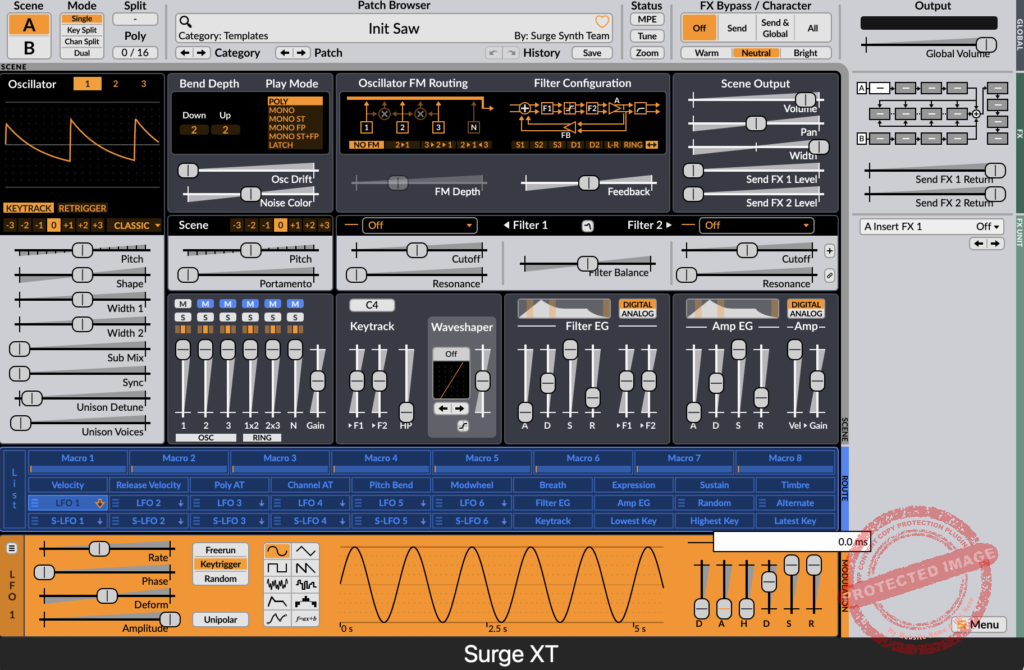
You know, I’ve lost count of how many times Surge XT has bailed me out when I needed a synth that could just do it all and do it well.
This beast is open-source, but let’s be real: it really rivals any flagship synth out there, no matter the price tag. I still can’t believe something this deep is actually free.
What gets me about Surge XT is that it packs everything into one plugin: subtractive, FM, wavetable, even audio input as an oscillator (which I use way too often for creative weirdness).
The interface is modern, sometimes a bit dense for a beginner, but once you’re used to it, it’s a total playground. I love how active the community is too; there are always new updates and fresh patches to explore.
- Versatile Oscillators & Wavetables
I’m constantly stacking the 3 oscillators per scene, there are 12 synthesis types, so I can go from analog fatness to digital bells, even drop in my own wavetables. Makes designing anything from glassy leads to gnarly basses honestly kind of addictive.
- Massive Modulation Engine
For me, the modulation section is where Surge XT gets bonkers. 12 LFOs, tons of envelope options, and you can route almost anything anywhere.
I often find myself patching LFOs into random FX or running envelopes into filters I didn’t even plan on using, there’s almost no limit, and it feels like modular without the headache.
- Epic Effects & Sculpting Tools
2 filters per scene, over 27 effects, ncluding some personal favorites like granular delay, vocoder, and ChowTape, mean you can go subtle or completely wild with your sounds.
I have to warn you, though, stack up too many effects and your CPU might groan a little.
Sure, the interface is a bit much if you’re just starting out, but you’ll get used to it. And with more than 2800 presets on tap, you’ll always have new ideas to try.
When I want to push sound design limits or need a rock-solid all-rounder in my lineup, Surge XT is always up to the challenge.
Surge XT comes in VST3, AU, CLAP, and LV2 formats for macOS, Windows, and Linux users.
5. Plugin Boutique Carbon Electra

For those who want instant synth gratification without getting tangled in endless menus, Carbon Electra is going to be right up your alley.
I love how everything you need is on a single screen, and even though it’s easy to use, there’s a surprising amount of power under the hood, enough for real sound design, not just tweaking presets.
The layout really makes me want to experiment; 4 fully-featured oscillators front and center, cool real-time displays for both the waveform and filter, and bright, modern graphics that double as hands-on guides.
Even when I’m starting from scratch, Carbon Electra feels intuitive (and actually kind of fun) to build evolving sounds, dirty basslines, or big lush pads.
- 4 Oscillators & Instant Analog Vibes
One of my favorite things is stacking all 4 oscillators with different waveforms (pulse, saw, triangle, sine, noise), then slamming them through unison or even FM for monster tones.
Osc sync and that handy +12dB boost make driving the filter into analog-style warmth ridiculously easy, and I can always count on it for fat, buzzing bass or punchy modern leads.
- Step Sequencer & Hardwired Modulation
Carbon Electra’s editable step sequencer is no joke, perfect for wild acid lines or motion-heavy sequences.
The hardwired 3 LFOs and modulation envelope each control a bunch of destinations, which means
I’m always a couple of clicks away from a snappy, animated patch. Sure, I wish there was a modulation matrix, but honestly, the direct controls make for a fast workflow and plenty of creative surprises.
- FX Section & Artist Presets
The built-in effects are like having your favorite stompboxes ready to go: chorus, delay, phaser, distortion, and an EQ.
I like how you can push the amp section “too hot” into the optional limiter for that modern, compressed sound.
And the best bit? There are over 800 factory presets, including banks from artists like Carl Cox and Freemasons, so if you’re ever stuck, you’re guaranteed to find inspiration.
- It’s friendly for beginners but deep enough for pros; great for cutting-edge EDM, classic analog emulation, or anything in between.
Carbon Electra comes in VST (Windows) and VST/AU (macOS) formats for 64-bit systems.
6. Imaginando FRMS
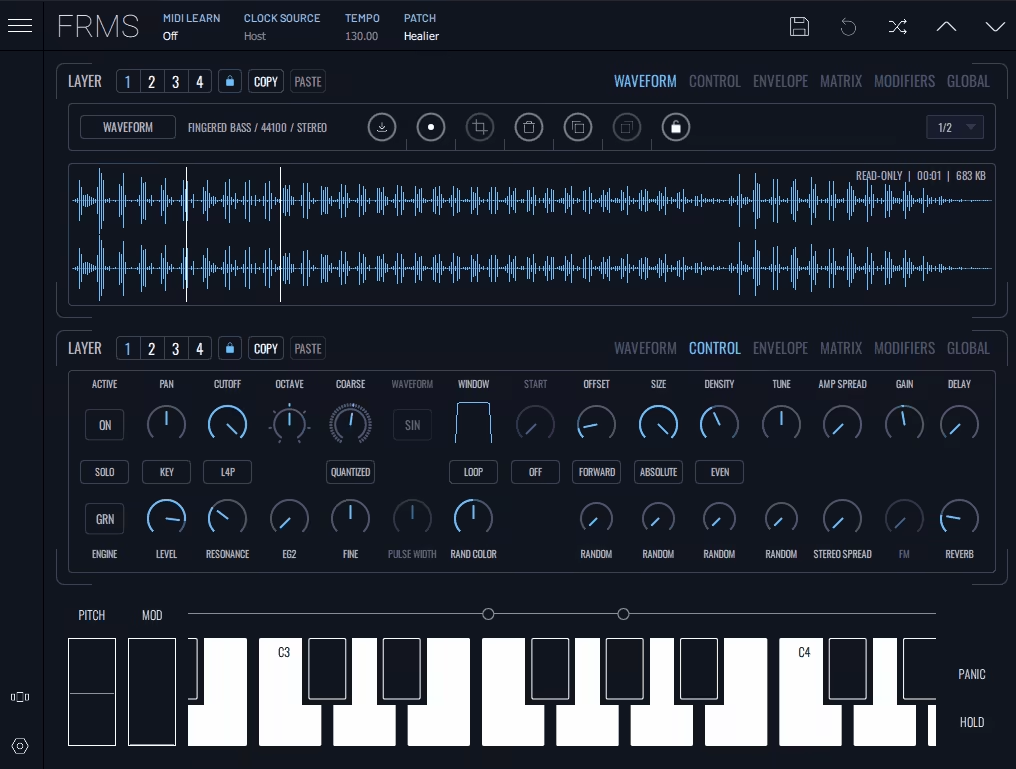
What immediately stands out to me about Imaginando FRMS is how it smashes together the best bits of subtractive, granular, and FM synthesis in one seriously flexible synth.
I’ve spent hours just exploring the multi-layered possibilities, sometimes it feels like sound design on FRMS is its own creative rabbit hole, in the best way possible.
The interface is surprisingly intuitive for such a deep synth. I love how you can work on two layers or panels side-by-side, making editing and comparisons super fast.
Even with so much power under the hood, it rarely feels overwhelming, plus, that built-in waveform view is perfect for visualizing exactly what you’re cooking up.
- Hybrid Engine: Granular, Subtractive & FM Synthesis
I can flip between classic analog-style waveforms and intricate, grainy soundscapes at a moment’s notice.
When I want otherworldly pads or evolving atmospheres, the granular engine is my go-to, the fact I can use my own samples or even a live track as a source just opens up a whole new universe of sounds.
- 4 Synth Layers With Flexible Routing
Each patch lets me build up to 4 independent layers, each with their own mode and wave shape. And when I’m ready to get wild, switching into FM mode turns those layers into FM operators, creating metallic, shimmering, and truly unpredictable results.
I honestly never get tired of mixing and matching different synthesis types for complex, evolving sounds.
- Creative Modulation & MPE Support
The modulation matrix per layer, plus 4 global LFOs, makes animated, morphing patches a breeze.
FRMS also plays beautifully with MPE controllers, so if you want touch-responsive, expressive sounds, it’s as fun as it is deep.
Heads up: all this power does demand a bit more juice from your CPU, and there are a few quirks with live input routing in some DAWs.
Still, for electronic producers and sound designers, FRMS is pure inspiration, perfect for anything from lush ambient pads to sharp leads and glitched-out textures.
If your usual synths are feeling a little “same-y,” this one will shake up your sound design.
Imaginando FRMS comes in VST3, VST, AU, and standalone formats for macOS, Windows, iOS, and Android users.
7. Arturia Prophet-5 V
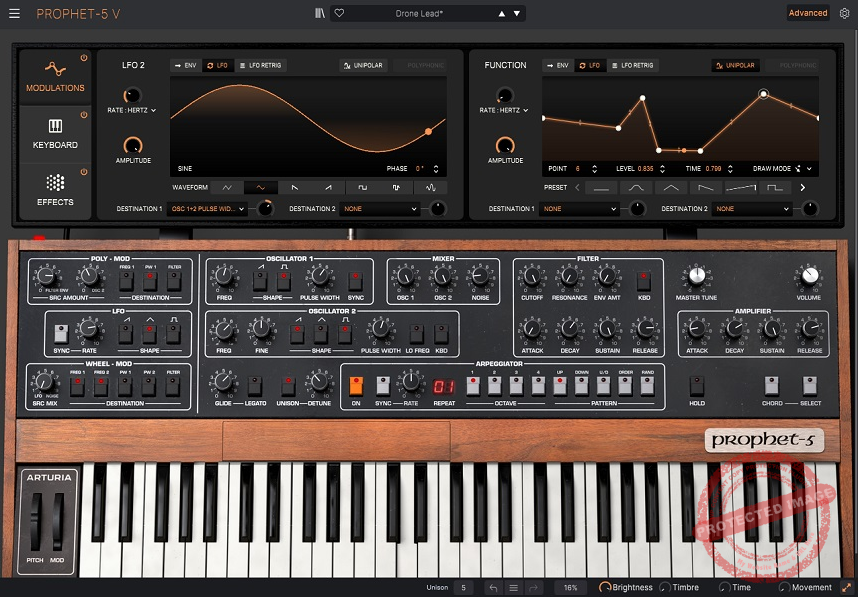
What truly makes Arturia Prophet V stand out for me is its double-whammy approach: it authentically recreates not just the classic Prophet 5 analog poly, but also the prophetic and sometimes-overlooked Prophet VS with its gnarly digital vector synthesis.
I get such a kick flipping between the warm, vintage lushness of the Prophet 5 and the metallic, glassy textures of the VS, they’re worlds apart, but with Prophet V, I get both in one plugin and there’s even a hybrid mode for the wild at heart!
The interface strikes that balance between “retro eye candy” and workflow efficiency.
I genuinely enjoy how Arturia made tough editing on the Prophet VS so much easier; those vector envelopes are now a breeze, and dialing up a hybrid patch is as simple as choosing routing with a few clicks.
- Dual-Synth Engine (Prophet 5 & Prophet VS)
My favorite thing here is that you can hop between analog and digital with a click.
When I want syrupy, classic polysynth goodness, the Prophet 5 mode nails it. Searching for metallic, evolving pads and wild motion? VS mode’s vector morphing is a blast I always find inspiration in its cleaner, more hi-fi sound.
- Hybrid Mode for Adventure Seekers
Hybrid mode is where things get spicy: blending the architectures gives me gnarly sounds impossible on the hardware.
Whether I’m layering Prophet 5 oscillators through digital filters, or mangling everything in the expanded modulation matrix, this is a playground for both sound design newbies and deep-dive synth geeks.
- Enhanced Modulation and Snappy Envelopes
I love the convenience of modern enhancements: extensive modulation (way more destinations than the hardware), MIDI sync, and snappy, ultra-fast envelopes for modern punch.
The Poly-Mod and Mono-Mod sections are faithful to the classics, but all those new options let me spice up patches in ways Prophet fans could only dream of back in the day.
Sure, there are a few quirks; factory sounds can be a tad soft on the top end compared to the real hardware, and the effects (chorus and delay) sometimes act a little wonky.
Honestly, I recommend Prophet V to anyone who wants that unmistakable Sequential “edge.” It’s my go-to for lush pads, ‘80s brass, glassy digital textures, and hybrid cross-breeds you can’t get anywhere else. I
If your productions ever feel stuck between analog and digital, Prophet V is a beautiful way to blur the line (and have a ton of fun in the process).
Prophet V comes in VST, AU, RTAS, and standalone formats for macOS and Windows users.
8. AIR Music Tech Bassline
If you’re after that warm, punchy analog bass vibe, but still want something flexible enough for modern tracks, AIR Music Tech Bassline might just be what your productions need.
The first time I loaded AIR Bassline up, I was hit with those classic, crunchy mono synth tones, think vintage gear from the ‘70s and ‘80s, but with extra sparkle and power under the hood.
The interface is refreshingly simple, so I find myself dialing in killer sounds fast without getting lost in endless menus. Whether I’m in the mood for straight-up bass, thick leads, or lush pads, Bassline always feels immediate and fun to play with.
It delivers that authentic analog experience, but with enough polish and thoughtful features to fit comfortably in a modern session.
- Authentic Analog Tube Circuit Modeling
My favorite feature is the tube circuit modeling inherited from AIR’s legendary Vacuum synth.
It gives every patch real character and warmth, especially when I push the drive and distortion. The basses punch through mixes, and leads shimmer with just the right crunch.
- Flexible Oscillator & Layering Options
At the core is a flexible oscillator that morphs through saw, octave-saw, square, and sine waves.
Plus, I love how you can add in a sub or fifth oscillator to instantly thicken your sound. It’s like having multiple synths working together, filling out the bottom end and adding harmonics that make your patches jump to life.
- Inspiring FX & Presets
You get AIR’s Creative FX, chorus, delay, compressor, reverb, and even the “Hype EQ” for sculpting low and high end.
I often end up picking from the 150+ factory presets if I want instant results or using them as a starting point to cook up something unique.
Bassline doesn’t dive into deep modular or wavetable zones; it’s more about hands-on analog feel, fast results, and plenty of classic flavor.
For anyone after those iconic analog basslines, thick leads, and warm pads, Bassline is a surprisingly versatile option that can fit into any modern production.
AIR Music Tech Bassline comes in AU, VST, VST3, and AAX formats for macOS and Windows users.
9. AIR Music Tech Vacuum Pro
Vacuum Pro shines with its commitment to real analog character, thanks to actual vacuum tube circuit modeling that alone takes it way beyond your average virtual synth.
I liked the interface, which gives ultimate vintage vibes, with big chunky knobs, distressed paint, and even little “Age” controls that let me dial in realistic analog drift when I want those dusty, old-school sounds.
Honestly, I enjoyed how hands-on Vacuum Pro is. Everything important is right in front of me, no menu-diving necessary and the dual-layer setup means I can stack, blend, or even split two fat patches for instant stereo width or quick layering tricks.
Plus, having 4 flexible oscillators per part (with sweepable wave shapes!) means I can seamlessly morph from triangle to pulse, or blend waveforms for totally unique timbres.
- Tube Circuit Modeling and Polyphonic Power
Vacuum Pro delivers real analog warmth, crunch, and grit at every stage, from the 6 virtual tube stages to the tube-driven filters and mixer.
I get everything from creamy 80s polysynth pads to punchy, modern leads, especially when I push the Quad Detune for thick, supersaw goodness.
- Dual Layers, Modulation Madness
The two-part engine is such a playground, sometimes I use both for massive trance chords, or split them for evolving rhythmic textures.
4 envelopes and a robust modulation matrix let me target nearly anything I want, including that fun tempo-synced LFO for wobbles and movement.
- Streamlined Editing and Instant Inspiration
When I’m moving fast, I rely on the Smart Sound Randomizer, it creates fresh patches or variations with just one click (and I can even lock certain sections to keep what I like).
For dialed-back edits, the “Smart Page” macro controls and macro knobs make tweaking complex sound parameters a breeze.
If you’re into subtlety, you’ll find that Vacuum Pro’s true character shines most when you lean into the saturation and tube emulation, run it totally clean, and things can feel a little flat.
The Quad Detune can get intense fast, so I recommend starting slow and dialing it in just right.
Honestly, I pull out Vacuum Pro when I want that classic warmth and hands-on vintage feel, dirty basses, lush pads, laser leads, or just when I want to twist knobs and get inspired.
Vacuum Pro comes in VST, AU, RTAS, and AAX formats for macOS and Windows users.
10. nakst Apricot (FREE)
Whenever I’m in the mood to spice up my tracks with something fresh, Apricot is often the synth I reach for.
Right from the first launch, Apricot gives me that “let’s have some fun” feeling with a super clean interface that invites experimentation and a hybrid synthesis engine that lets me blend classic waveforms with creative sample manipulation in no time.
I have a blast layering those two main oscillators, each rocking 6 classic waveforms and a lush Supersaw emulation that screams classic trance.
That third sub-oscillator? It’s just what I need for dialing in thick, punchy lows. Toss in the sample layer (yes, you can import your own WAVs), and you’re off to the races making patches that sound way bigger than they should.
- Flexible Oscillators & Supersaw Unison
Both main oscillators give me classic analog flavor with all the waveforms I want, plus a phase offset option for extra movement.
When I hit unison mode, that JP-8000 Supersaw magic appears, it really fills up the stereo field for trance, pads, or even plucky chiptune leads.
- Sample Layer & Deep Modulation Matrix
I love being able to drop in a drum hit, vocal chop, or weird FX sample, then mangle it inside the synth’s sampler layer with looping and keytracking.
Two mod envelopes, two LFOs, and a full matrix with 16 slots mean I can make patches that evolve, drift, or bounce with the beat. Hovering over a control even shows you what’s modulating it, so intuitive.
- Arpeggiator, Effects, and Sleek Workflow
The arp here is honestly perfect for anything rhythmic, you can even skip envelope retriggers for classic chiptune action.
5 built-in effects (including that Virus-inspired distortion and ping-pong delay) are right there on the page, so I can polish a patch in seconds. I also dig the clean, two-page UI and the scaling, never feels cluttered, and those filter controls are exactly where I want them.
Downsides? You’ll need a Windows machine and a CLAP-compatible DAW, but if that’s you, Apricot is a killer addition. Whenever I want to combine samples with serious analog modeling or just get some inspiring, huge-sounding patches fast, Apricot always delivers.
Apricot comes in CLAP format for 64-bit Windows users.
11. u-he Hive 2
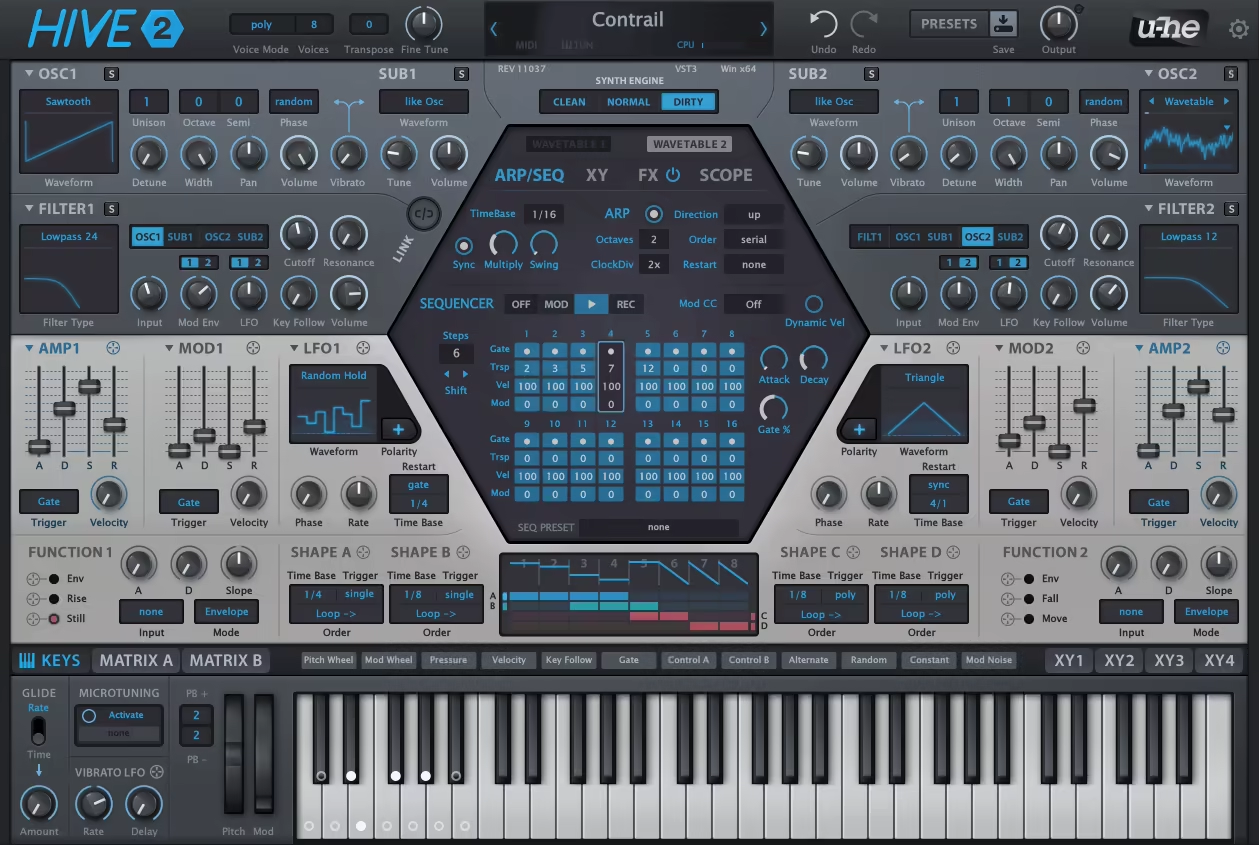
If you want big sounds fast, Hive 2 is your synth.
I love how the sleek interface means I can build everything from tight basses to full-on cinematic pads without clicking through endless menus.
Hive 2 is pretty light on CPU but supercharged with features, including wavetable support, three distinct synth engines, deep modulation, and drag-and-drop routing.
The 2 main oscillators handle everything from vintage analog to 2D wavetable action with up to 16-voice unison.
For creative movement, the shape sequencer and function generators let me craft wild modulations, while the 12-slot modulation matrix (with built-in modifiers) invites endless experimentation even on effect parameters.
- Wavetable Wizardry & Flexible Routing
Wavetables here go deep: I can modulate, animate, and even write custom UHM scripts for my own sounds. The engine swapping option and multi-table support unlock advanced sound design tricks that I never get bored with.
- Creative FX & Performance Tools
Hive 2 gives me 7 high-quality effects, and I can rearrange the chain in seconds for perfect vibe sculpting. Scope visualizations, intuitive XY pads, and microtuning round out a killer toolbox for both live tweaking and studio wizardry.
- Instant Inspiration
With 2,400+ factory presets and a fully scalable interface (including the striking Izmo skin), Hive 2 is one of my absolute go-tos when I want polished, powerful patches in no time.
Plus, the arpeggiator/sequencer module is unexpectedly deep for quick melodic riffs.
The best part? It runs on almost anything and keeps up with much heavier synths, whether I’m making club bangers or shimmering retro soundscapes.
Hive 2 comes in VST2, VST3, and AU formats for macOS, Windows, and Linux users.
12. AIR Music Technology TubeSynth
Looking for lush, vintage analog poly sounds with a modern touch? TubeSynth nails it.
Right away, I was impressed by the warmth and punch in its presets, thanks to Tubesynth’s advanced analog modeling.
The hands-on layout is made for quick tweaks, with 3 flexible oscillators, 2 unison modes for big chords, and a creative filter section for smooth pitch slides and fat analog runs.
- 3-Oscillator Engine & Harmonic Control
I loved diving into custom patches using the 3 oscillators, where I can blend noise, saw, pulse, square, and triangle waveforms.
Oscillator 2 even offers EQ and drive shaping, so I can add extra grit and presence, while the ring mod expands things further for wild, evolving textures.
- Award-Winning Effects & Hype EQ
The built-in effects are a huge plus, chorus, delay, reverb, compressor, and that awesome Hype EQ for instant thickening or sparkle.
I use the Low Hype to beef up my basses, and High Hype to give pads and leads some shimmer. Everything’s right at my fingertips, and the effects sound polished and ready to go.
- Performance Features
With 300+ presets with pads, plucks, FX, organs, you name it, I’m always stumbling on inspiration.
There’s a standalone desktop app (great for jamming with a MIDI controller) and full support for all the major plugin formats.
Downsides? Nothing major, it’s just a straightforward, inspiring synth that’s easy to use and sounds great, whether I’m dialing in analog nostalgia or layering up futuristic polys.
TubeSynth comes in VST, VST3, AU, and AAX formats for macOS and Windows users.
13. Nakst ExtraBold
ExtraBold caught my eye right away by managing to be both super approachable for beginners and surprisingly fierce once you start tweaking.
In ExtraBold you’ve got 3 fat subtractive oscillators and a multi-mode filter at the core, with all the classic tricks, but also goodies like filter FM, hard sync, global unison, and even comb filtering for extra bite.
I get a kick out of the 4 LFOs lined up in the middle; it looks simple, but combining them lets me dial in evolving, animated sounds that are anything but boring.
- 4 LFOs & Simple Modulation Pipeline
Even though you can’t assign modulation freely, the fixed pipeline actually makes life easy: I just pick a sound and start sculpting, letting those LFOs bring the timbre and pitch to life. It’s all about helping me focus on classic, playable results without messing around.
- 3 Effect Slots With Real-Time Control
The 3 flexible effect slots are a real treat: I get delay, reverb, tone, chorus, and distortion, and can mix and match between them for surprisingly rich results.
Mapping any effect to my mod wheel is a blast for live playing, great for on-the-fly creative flair.
- CLAP-First Plugin & Highly Optimized
Built for the modern CLAP plugin format, ExtraBold is crazy efficient; no matter what system I’m on, it just works.
Plus, with native support for everything from old-school Intel chips to the newest Apple Silicon, and support for advanced features like polyphonic modulation, it feels very much like the future of plugins.
Sure, it’s not for wild modular routing, but when I want punchy, classic subtractive sounds without a headache, ExtraBold is the fun, friendly, and surprisingly bold synth I grab.
ExtraBold comes in CLAP and AU formats for macOS, Windows, and Linux users.
14. HY-Plugins HY-POLY
The first thing I noticed with HY-POLY is just how much creative control it throws at you.
I gotta say this is not your average subtractive poly synth! Diving in and seeing everything laid out is great with multiple oscillator modes, dual multimode filters, and a toolbox overflow of MIDI and audio effects.
Whether I’m looking to sculpt lush pads, punchy basses, or glitchy leads, HY-POLY makes it all feel super intuitive with a sleek, resizable interface that never feels cluttered.
The drag-and-drop modulation workflow is a total win for me. I can quickly route envelopes, LFOs, or even MIDI effects to pretty much anything; no endless menu chasing.
With 24 modulation sources ready to go and plenty of on-board MIDI and audio FX units, it’s ridiculously easy to breathe life into even the most basic patches.
- Loads of Oscillator Power
With 5 different oscillator types (including vector and phase distortion!), I’m spoiled for choice before I even touch the filters.
Whether I’m stacking up 3 oscillators, working with classic subtractive sounds, or building complex textures with the mod or vector options, there’s a ton of range to play with.
- Dual Filters & Drag-and-Drop Modulation
Having two multi-mode filters in series or parallel means I can really carve and shape my tone.
The best part? I just drag a modulation source over, drop it, and the routing is done, instant movement and expressiveness with no fuss.
- Deep FX and Flexible Workflow
25 audio FX and 9 MIDI FX units let me get as wild or as subtle as I want with my patches.
I love that I can quickly set up arpeggiators, velocity effects, audio reverbs, distortion, and more. Plus, with MIDI learn and a handy preset browser, performance and patch management are a breeze.
Sure, the free version is purposely limited (single oscillator, four voices, no MIDI FX), but it’s still a great way to dip a toe in the water and see what this beast can do.
Honestly, HY-POLY is one of those synths I reach for when I want modern sound design without leaving classic poly vibes behind.
HY-POLY comes in VST2, VST3, and AU formats for macOS and Windows users.
15. Matt Tytel Helm
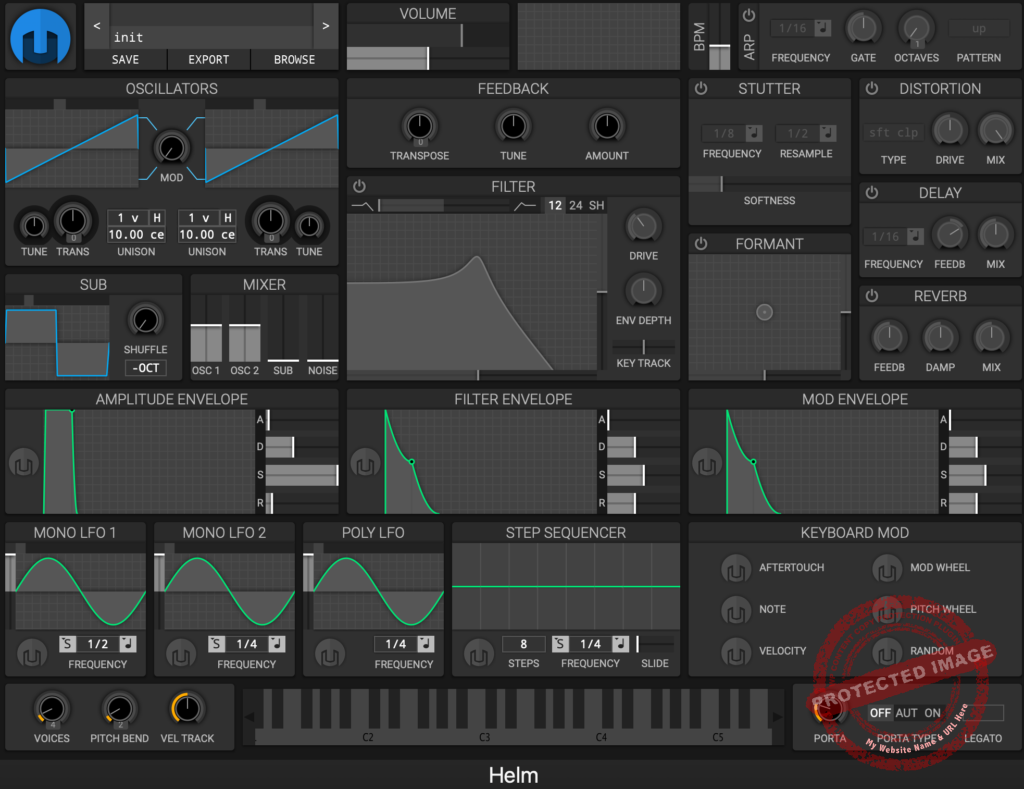
There’s something about Helm that always makes me smile; it’s quirky, punchy, and wears its digital color on its sleeve.
When I first discovered it, I couldn’t believe a free synth could have such a playful interface and so many creative tricks.
Navigation is a breeze, thanks to a clear, colorful layout and a super-friendly modulation system: just tap the helmet icon, and drag modulation wherever you want it.
The engines in Helm have a bit of an attitude. With 2 oscillators (each rocking 10 wave shapes and some wonderfully odd cross-modulation), you’ll get tones that range from uniquely digital to downright harsh.
Honestly, I have a blast making aggressive leads and energetic effects, especially after adding feedback, drive, or running it through the incredibly fun stutter effect or formant filter.
- Instant Modulation & Sound Shaping
The real star for me is Helm’s modulation: 3 LFOs, 3 envelopes, and a beefy step sequencer, all modulatable and super visual.
The feedback, oscillator drive, and filter section (with seven types!) open up a world of gritty percussive plucks; plus, everything responds snappily to fast mod changes.
- Unique Effects & Arpeggiator
Aside from must-haves like saturation, delay, and reverb, you get a formant filter and a glitchy stutter effect (great for EDM or turning basic sounds into ear-catching textures).
The built-in arpeggiator goes up to 4 octaves, with 5 playback patterns and modifiable settings, one of those hidden gems for instant rhythmic inspiration.
- Total Freedom-And Open Source
What really keeps Helm in my toolkit is the sense of creative freedom. It’s open-source, cross-platform, and runs anywhere; no DRM or hassles.
I use it for quick sketching, lo-fi digital weirdness, or when I just want something that sounds “bad in a good way” (trust me, that’s a compliment in context).
It may not replace your flagship analog soft synth, but for raw, spiky leads or percussive squelches, Helm’s got a personality all its own. Plus, it’s totally free, so if you haven’t tried it, fire it up and let your weird side run wild.
Helm comes as a standalone app or VST, VST3, AU, and LV2 plugin for Windows, macOS, and Linux users.
How Does Subtractive Synthesis Work?
Subtractive synthesis starts with harmonically-rich waveforms, then uses filters (low-pass, high-pass, etc.) and envelopes to remove or shape frequencies, creating expressive and dynamic synth sounds.
Subtractive Synthesis vs Additive vs FM
Subtractive synthesis removes frequencies from waveforms, additive synthesis builds sounds by stacking pure tones, and FM (frequency modulation) synthesis creates complex tones by modulating one oscillator's frequency with another.

